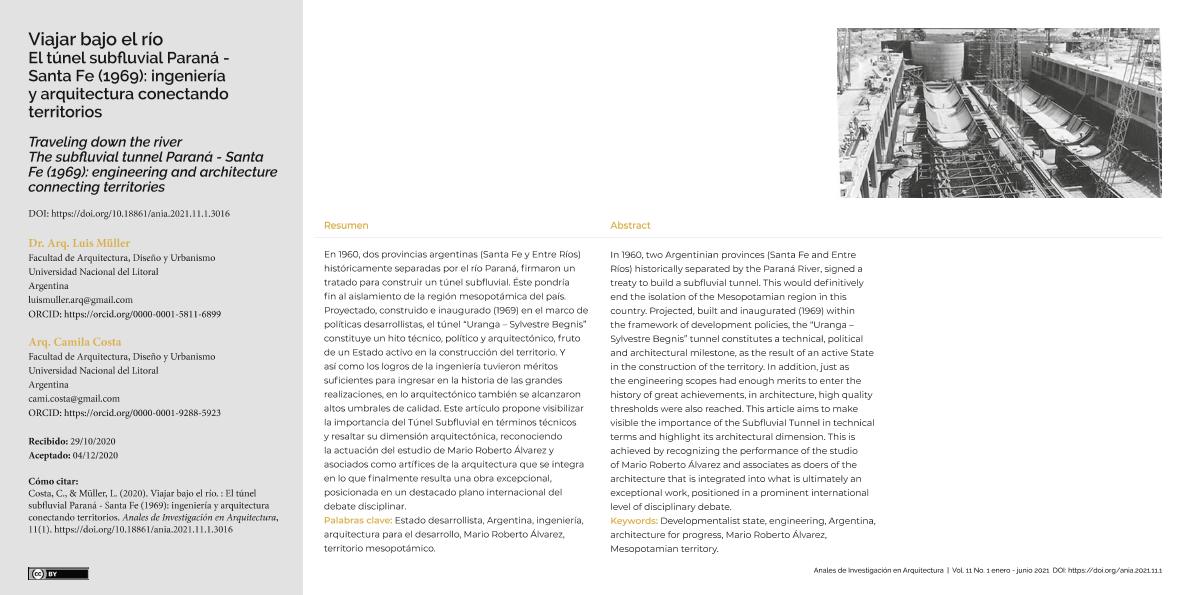Artículo
En 1960, dos provincias argentinas (Santa Fe y Entre Ríos) históricamente separadas por el río Paraná, firmaron un tratado para construir un túnel subfluvial. Éste pondría fin al aislamiento de la región mesopotámica del país. Proyectado, construido e inaugurado (1969) en el marco de políticas desarrollistas, el túnel “Uranga – Sylvestre Begnis” constituye un hito técnico, político y arquitectónico, fruto de un Estado activo en la construcción del territorio. Y así como los logros de la ingeniería tuvieron méritos suficientes para ingresar en la historia de las grandes realizaciones, en lo arquitectónico también se alcanzaron altos umbrales de calidad. Este artículo propone visibilizar la importancia del Túnel Subfluvial en términos técnicos y resaltar su dimensión arquitectónica, reconociendo la actuación del estudio de Mario Roberto Álvarez y asociados como artífices de la arquitectura que se integra en lo que finalmente resulta una obra excepcional, posicionada en un destacado plano internacional del debate disciplinar. In 1960, two Argentinian provinces (Santa Fe and Entre Ríos) historically separated by the Paraná River, signed a treaty to build a subfluvial tunnel. This would definitively end the isolation of the Mesopotamian region in this country. Projected, built and inaugurated (1969) within the framework of development policies, the “Uranga – Sylvestre Begnis” tunnel constitutes a technical, political and architectural milestone, as the result of an active State in the construction of the territory. In addition, just as the engineering scopes had enough merits to enter the history of great achievements, in architecture, high quality thresholds were also reached. This article aims to make visible the importance of the Subfluvial Tunnel in technical terms and highlight its architectural dimension. This is achieved by recognizing the performance of the studio of Mario Roberto Álvarez and associates as doers of the architecture that is integrated into what is ultimately an exceptional work, positioned in a prominent international level of disciplinary debate.
Viajar bajo el río. El túnel subfluvial Paraná-Santa Fe (1969): ingeniería y arquitectura conectando territorios
Título:
Traveling down the river. The subfluvial tunnel Paraná-Santa Fe (1969): engineering and architecture connecting territories
Fecha de publicación:
01/2021
Editorial:
Universidad ORT
Revista:
Anales de Investigación en Arquitectura
ISSN:
2301-1505
e-ISSN:
2301-1513
Idioma:
Español
Tipo de recurso:
Artículo publicado
Clasificación temática:
Resumen
Palabras clave:
ESTADO DESARROLLISTA
,
ARGENTINA
,
INGENIERÍA
,
ARQUITECTURA PARA EL DESARROLLO
Archivos asociados
Licencia
Identificadores
Colecciones
Articulos(CCT - SANTA FE)
Articulos de CTRO.CIENTIFICO TECNOL.CONICET - SANTA FE
Articulos de CTRO.CIENTIFICO TECNOL.CONICET - SANTA FE
Citación
Müller, Luis; Costa, Camila; Viajar bajo el río. El túnel subfluvial Paraná-Santa Fe (1969): ingeniería y arquitectura conectando territorios; Universidad ORT; Anales de Investigación en Arquitectura; 11; 1; 1-2021; 4-14
Compartir
Altmétricas




